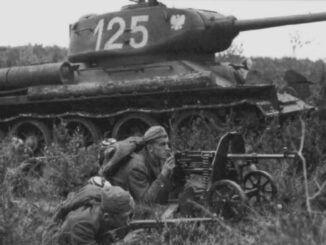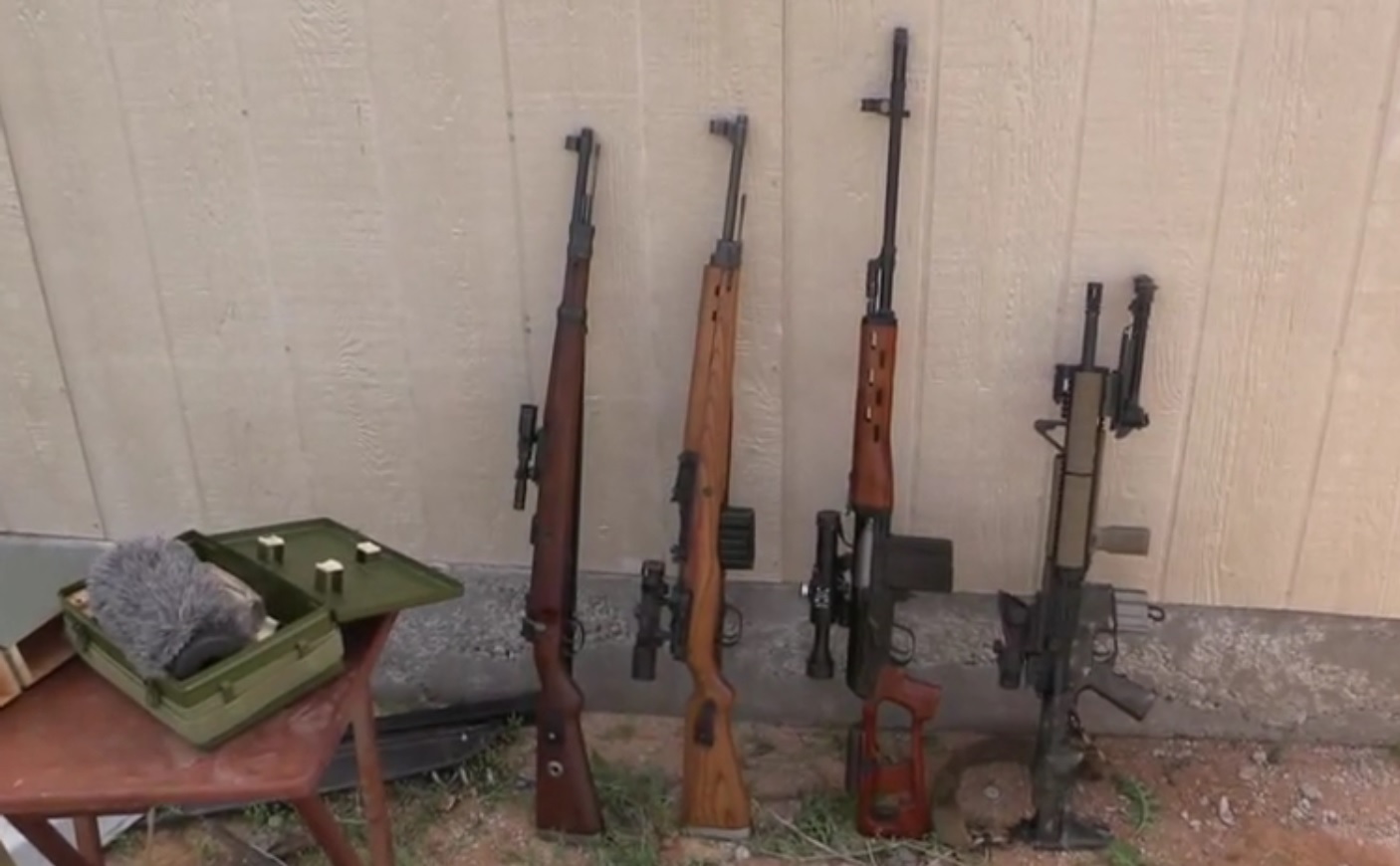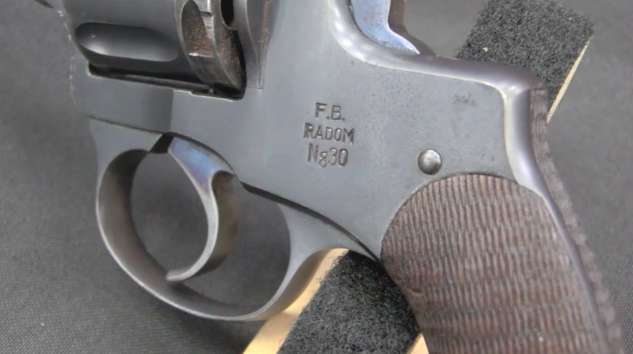This rifle is lot #1019 at Morphy’s April 2019 auction.
The AVS-36 was the first self-loading rifle adopted by the Soviet Union to be a standard infantry rifle, and it was not just semiautomatic, but also capable of fully automatic fire. Designed by Sergei Simonov over the course of about ten years, it would only last a short time in service before being replaced by the Tokarev SVT-38 and then SVT-40.
The AVS-36 uses a short stroke gas piston system that remains popular to this day, and a quite unusual locking system incorporating two asymmetrical locking flaps and a vertically traveling locking block. It is striker fired, with semi and full auto selector positions and a 15-round detachable magazine (plus stripper clip guide). In total, 65,800 were made between 1934 and 1940, with true mass production beginning in 1937.




Some will go crazy when seeing “battle rifle” :-)))
Yes, because it is avtomaticheskaya vintovka (or avtomatičeskaâ vintovka for ISO-9 believers), first part is used in Russian terminology solely for weapons capable of full-auto fire (c.f. APS alias Stechkin).
Self-loading i.e. samozaryadnaya in this* case (or samozarâdnaâ for ISO-9 believers) adjective is used solely for weapon which fire 1 shot at each trigger pull (if magazine is not depleted), without needing any other action to be undertaken (c.f. SKS).
Even if in AVS-36 case full-auto fire was supposed to be used only in special circumstances (enemy attacking and being at distance no more than 150 meters) it still belong to first described category, as being able to fire full-auto.
* Russian language is fusional
Mostly, the AVS-36 was an early example of why full-auto fire in a standard-weight rifle firing full-power ammunition was not a practical proposition.
Two decades later, the U.S. Army Ordnance Department proved it again, with the T-47 development project which resulted in the M14.
Meanwhile, Russia sensibly took a page from the Wehrmacht’s book and standardized the Kalashnikov in 7.62 x 39mm. Essentially, a Russian iteration of the German MaschinenKarabiner concept in 7.9 x 33mm.
As Ian Hogg said, nothing can give you a good appreciation of a weapon system’s capabilities faster than being on the receiving end of same.
cheers
eon
The problem with that is Army Ordnance dismissed the intermediate-strength assault rifle as an overly fragile fancy pampered poodle that could easily be destroyed by having a soldier accidentally sit on the receiver. Two-hundred pounds of soldier concentrated in the rump area tend to be a bad thing to put atop a stamped machine-carbine receiver! Trust me, the number of idiots in the field who would actually sit on their guns even today defies common sense.
I was taught the only piece of equipment you sat on was your entrenching tool, in a troop glider or halftrack.
In a glider, it gave you at least some protection against having to have a chunk of flak shrapnel pulled out of your arse. In an APC, the same with a chunk of mine.
cheers
eon
“took a page from the Wehrmacht’s book and standardized the Kalashnikov in 7.62 x 39mm. Essentially, a Russian iteration of the German MaschinenKarabiner concept in 7.9 x 33mm.”
In narrow scope – yes. But in more wide – Germans perceived only need of machine carbine firing inter-mediate cartridge, while Soviets quickly concluded that they need trinity of weapons firing intermediate cartridge: self-loading carbine (would result in SKS), machine gun (would result in RPD) and avtomat – last one being actually “youngest” if we consider dates of launching high-scale production.
I guess the Avtomat competitions were the indirect results of lots of combat trial and error, when the Red Army realized that the traditional “one shot=one kill” idea for infantryman’s rifle training wasn’t working. The SKS wasn’t making things much better, as it was still loaded by stripper clips, and the RPD isn’t intended for on-the-sprint snap-bursts. “Why bother with three long-arm cartridges if we can craft a family of rifle, machine gun, and Avtomat for the jack-of-all-trades? We’ve already got the rifle and machine gun, by the way!”
As you’ve already mentioned years before, the Red Army did not merely select a design of Avtomat “because Stalin said so.” Competition allowed the generals to see how the contestants’ weapons performed compared to each other and to the weapons of the past (including domestic, captured, and the token weapons leased from the Western Allied powers). A weapon selected purely through political opinion without live-fire field testing would likely backfire on whomever made that decision. I hope I’m not totally wrong here.
“(…)RPD isn’t intended for on-the-sprint snap-bursts.(…)”
Actually RPD manual does support “firing on moving without halt”, for more data see point 131. here: https://arsenal-info.ru/b/book/3213146621/11
“(…) traditional “one shot=one kill” idea for infantryman’s rifle training wasn’t working(…)”
New avtomat was deemed as further development of sub-machine gun (mostly PPSh) concept, which was to provide further reach in first place.
“(…)SKS wasn’t making things much better, as it was still loaded by stripper clips(…)”
It is very risky hypothesis, considering that unlike short versions of Mosin it replaced was not:
– bolt-action repeating rifle
– firing 7,62×54 R cartridge, which give… remarkable recoil
Therefore it can be concluded that SKS allowed smaller amount of time between (aimed) shots.
The rifle is overly complex (in locking arrangement), but this is to be expected due to its pioneering role. Previously prevalent recoil operated or gas-trap operated guns were even more complex and often clumsy. Simonov had gone “long way” when he eventually arrived to his landmark SKS. He was undoubtedly a talented man.
“(…)overly complex(…)”
Actually it was first rifle of its kind to work well enough to be considered worth launching high-scale production. Keep in mind that over 100 various patterns (systems) were tested before with results varying greatly, but none was considered good enough to launch high-scale production.
“(…)Simonov(…)”
Excluding said SKS and PTRS, other S.G.Simonov weapons seems to have bad luck in area of suiting to then current demands. He designed a lot of various fire-arms during his career, most remained prototypes see drawings (keeping in mind that list is far from being complete): http://www.dogswar.ru/oryjeinaia-ekzotika/strelkovoe-oryjie/5874-eksperimentalnoe-ory.html
And excluding SKS, others namely AVS-36 and PTRS-41 proved to be short lived in terms of production time.
““long way””
After switch from AVS-36 to SVT, S.G.Simonov worked on enhancing his design, which finally resulted in СКС-30-П-41г. and СКС-31-П-41г. See photos: https://www.kalashnikov.ru/sks-kotoryj-tak-i-ne-vstupil-v-boj/
Unlike, well known SKS, these used 7,62×54 R cartridge, first one has capacity 10 and was feed from clips (NOT strippers), while second has capacity 5 and accepted Mosin strippers. Otherwise they were identical.
Second one was tested on proving ground with positive results, its light mass (2,9 kg – without bayonet) was noted as allowing increase of carried ammunition. 1 June 1941 test batch (50 examples) was ordered, which was supposed to be troop-tested in July 1942. With outbreak of Great Patriotic War these actions were halted. In May 1942 factory No.74 was supposed to be make them, but failed due to already realized orders required by front. In June 1942 factory No.314 was given that order, but it did not even starting after deadline. All strain was given to production of Tokarev rifles, so 3 examples of Simonov carbine were ready in December 1943. Complete 50 examples were ready in May 1944. 14 June 1944 37 examples were sent to acting army. Feedback was shortly speaking: “enhance reliability”. At that point 7,62×39 was already soon to be introduced, so no more resources were assigned to development of self-loading rifles for 7,62×54 R cartridge.
Thanks for further information. It is true that Sergey Simonov was exceptional talent. He attempted almost impossible while still using large 7.62x54R round – and almost succeeded.
Describing it I have “I saw something like this” feeling and it was history of Tantal. If you do not know about what I am writing then read: https://www.forgottenweapons.com/rifles/wz-88-tantal/
After each iteration – new requirements meaning need of further development, several time, to finally get into situation “uhm… now we do not this weapon anymore” yet experience gained not wasted totally, as it was utilized in next weapon.
“while still using large 7.62x54R round”
No size is not problem, that R for rimmed nature is culprit. Note that Swiss used similarly sized 7,5×55 cartridge, but rimless and they did not have problems with magazines for Stgw.57. It is not coincidence that Soviet weapon firing 7,62x54R cartridge and requiring capacity above 15…20 did not used box magazines.
“Sergey Simonov was exceptional talent”
He never managed to repeat success of SKS-45, which was still relatively early in his career. It is interesting to compare that for history of V.I.Silin:
http://samlib.ru/k/krasilxnikow_o_j/silin.shtml
as he was active in weapons development at least since 1935, but none of his weapons went into wide production until 1963 (SPG-9).
Thank you Ian!! As soon as that auction catalog came out I was hoping we would get a closer look, and you did not disappoint!!
The spammers are back! This means war!!
I will clear them as I am able to, and hopefully it won’t be long before the automated system starts recognizing these. Sorry for the inconvenience.
Thank you so much! [salutes]
Keeps saying to me this page isn’t working, no shit.
Are the “locking” flaps a, sort of bolt delay; with the wedge being the lock… Kinda, locked/delayed. The unlock happens quick, but is slowed by the flaps; early gun “good like for the time” might have to watch again, etc he he. Er, like those rate reducer things.
Would be interesting to compare directly to an SKS and see what the design holdovers are: the turnkey pins fore and aft, the receiver cover, the bolt carrier handle and recoil spring, even the trigger guard impinging on the magazine well. How much better a weapon the SKS would have been with a removable box magazine, though at the expense of many satisfied current owners in mag-restricted jurisdictions. I have read that Stalin personally ordered a fixed magazine to save expense.
Detachable magazines were great if factories made their dimension tolerances consistent. Given the expenses in crafting magazines and material losses during the war, I’m not particularly surprised that the SKS has a fixed magazine.